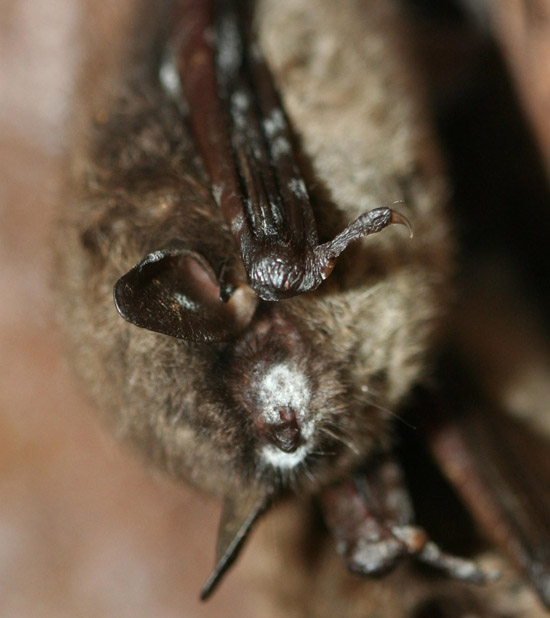AUGUSTA — A mysterious disease that has killed more than a million bats in the eastern and southern United States has been confirmed in Maine as it continues its spread across North America, officials said today.
The disease known as white-nose syndrome was found this spring in mines in western Maine where bats hibernate during the winter. First identified in upstate New York in 2006, the disease has now been confirmed in 17 states from Maine to Tennessee and in four Canadian provinces.
“As it continues to spread we don’t see anything slowing the spread of the fungus down,” Ann Froschauer of the U.S. Fish and Wildlife Service said during a conference call with reporters. “We’re down into North Carolina and Tennessee and into the Midwest in Kentucky and Indiana and Ohio, and we don’t seem to see any slowing down of the fungus being spread among bats in those areas.”
The disease was most recently confirmed in bats found in two mines in western Maine that were surveyed this spring. The state’s third known bat-hibernation site, in northern Maine, showed no signs of the disease, said John DePue, a wildlife biologist with the Maine Department of Inland Fisheries and Wildlife.
The spread of white-nose syndrome could have significant ecological consequences. The million bats already killed would have eaten roughly 1.5 million to 3 million pounds of insects a year, providing pest-control services for farmers and forest managers, officials said.
With bat populations going down, the volume of mosquitoes and other pests — including those that damage agricultural crops and trees — is going up. A recent study published in the journal Science has estimated that the insect-eating bats save the U.S. agricultural industry at least $3 billion a year in pest-control services.
The spread of the disease could result in more crop and tree damage and in the increased use of pesticides to control pest populations.
Scientists don’t know for sure where the fungus came from, although indicators suggest it might have come from Europe, officials said.
They also aren’t exactly sure how it kills bats, but one theory is that the fungus irritates the noses, wings and ears and causes bats to often awaken during hibernation and burn so much energy that they starve to death before spring. Scientists also believe the fungus erodes tissues and disrupts the bats’ abilities to regulate their temperatures and stay hydrated.
It does not affect humans, but the fungus can be spread by people. Officials are urging cavers and researchers to stay away from caves and mines during winter hibernation months. People are being asked to allow bats roosting in their homes and other structures to rear their young and exit the structures at the end of the summer before closing off any entrance holes.
The disease has been confirmed in Connecticut, Delaware, Indiana, Kentucky, Maine, Maryland, Massachusetts, New Hampshire, New Jersey, New York, North Carolina, Ohio, Pennsylvania, Tennessee, Vermont, Virginia and West Virginia, as well as New Brunswick, Nova Scotia, Ontario and Quebec.
Two additional states, Missouri and Oklahoma, have identified the fungus but not the disease, Froschauer said.
Send questions/comments to the editors.



Success. Please wait for the page to reload. If the page does not reload within 5 seconds, please refresh the page.
Enter your email and password to access comments.
Hi, to comment on stories you must . This profile is in addition to your subscription and website login.
Already have a commenting profile? .
Invalid username/password.
Please check your email to confirm and complete your registration.
Only subscribers are eligible to post comments. Please subscribe or login first for digital access. Here’s why.
Use the form below to reset your password. When you've submitted your account email, we will send an email with a reset code.